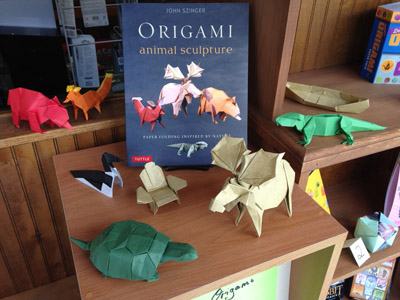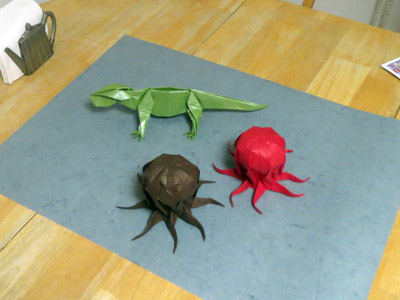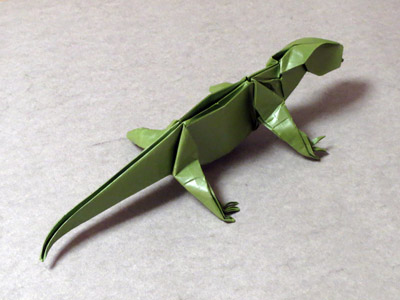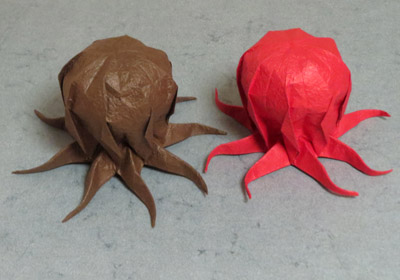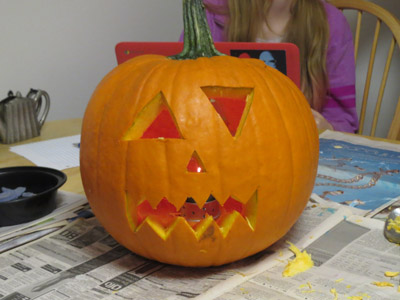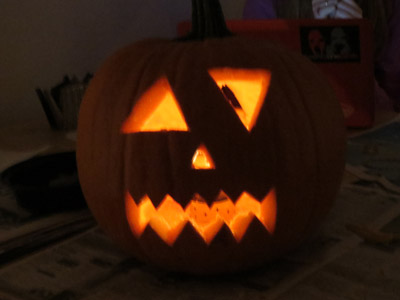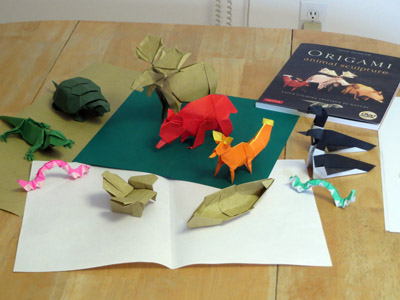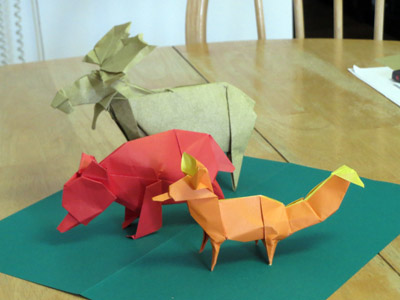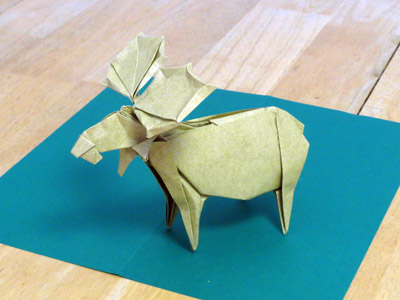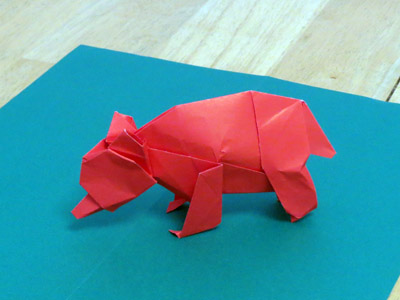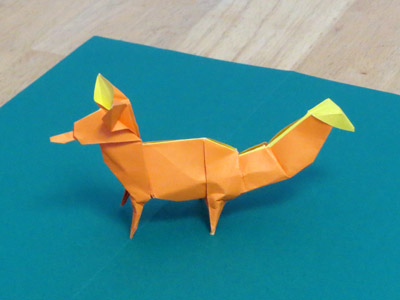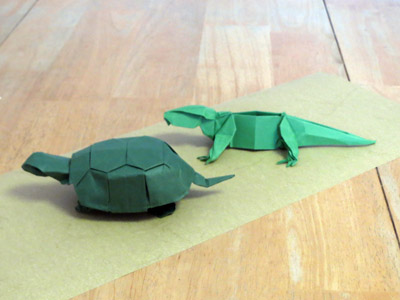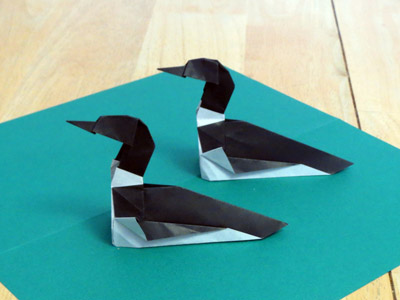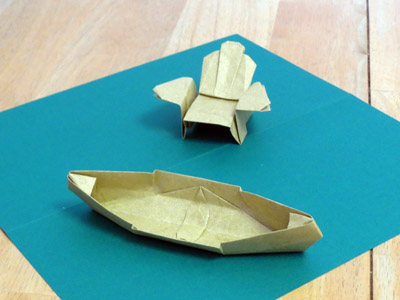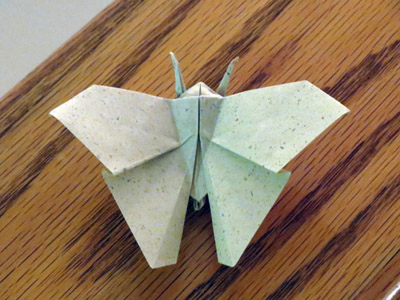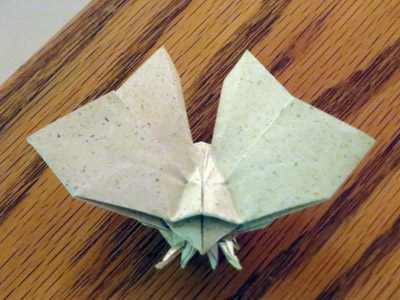Here it is. The good folks at The Bookstore Plus put a nice display of my book and the models I sent them. While they were at it they also had an origami contest. Congratulations James!
Month: November 2014
2014 Origami Holiday Tree
There seems to be a theme right now of reprising origami from my book for various exhibitions. For the annual Holiday Tree at the American Museum of Natural History Ros from OUSA asked me to contribute one of Lizards and a couple of my Octopi. She provided me with really cool papers. The Lizard paper is called Stardream. It’s thickish and kinda sparkly. The one had was large (maybe 20”) and green. Perfect. The paper for the Octopi was foil backed with a crinkly texture, one red and one brown, maybe 15” square. Also came out very nice. I ended up folding the octopi up in Boston cuz I was behind schedule. The larger size made it hard to sculpt the finishing stages, and I had to use a spoon instead of a finger on the inside. I dropped them off at the museum one day last week on my lunch break. It was a crisp autumn day, great for a walk thru Central Park.
While we’re at it here are some pics from our Hallowe’en Jack o’Lantern this year, designed by Michelle.
Adirondack Origami Exhibition
Up in Lake Placid, not far from North Pole, NY, there’s a really cool bookstore called The Bookstore Plus (www.thebookstoreplus.com). A while back they contacted me asking if I could to a book signing there for my new origami book, Origami Animal Sculpture. This I thought was very cool because my book has a strong Adirondack connection. Unfortunately Lake Placid is a pretty long trip for me and I haven’t been able to schedule a time yet. So instead I did the next best thing and sent them a box of origami they could use to make a display to help promote the book. No word yet from them on whether it arrived or what exactly they plan to do with it. But if you’re in the Placid area and you happen to pop in, please take a look. I’d love to see how it turned out.
OrigaMIT IV
I just got back from what’s becoming an annual autumn tradition: the MIT Origami conference, a.k.a OrigaMIT. First off, it’s a great time of year for a drive up to New England, with the leaves turning red and gold contrasted against all kinds of vivid, changing blue and grey skies.
This year was the best one yet. Thanks to Jason Ku and the MIT Origami Club for putting it all together. It’s grown to over 200 attendees, but still feels cozy and intimate. I saw a bunch of origami friends, although I didn’t have the chance to do more than say hi more than I would have liked. I exhibited a few “greatest hits” animals from my book, the one-sheet polyhedra from Uyen’s exhibit this summer, and a couple new models including my Single-Sheet Dual Interlocking Cubes with Color Change, and a new butterfly currently known as Butterfly III.
I don’t normally go to many classes at conventions, preferring mainly to teach and hang out, but this year I went to three. The first was Joseph Wu’s faces. Joseph is a great guy, creative, friendly and articulate, and I haven’t seen him in a few years because he’s on the west coast. Rather than teach a finished model, he taught his “face base” and then had the class freestyle to finish the model each in his own way, making creative discoveries along the way. His base focused on the nose and mouth, but the eye treatment was incomplete, so I began focusing on that. It was fun and interesting. I’ve had the idea to experiment with faces for a long time, but didn’t really have a good way in to get started. Seemed like a pretty big break from the other stuff I’m doing. Now I hope I can make the time to continue these explorations and develop something cool.
The second class I took was Paul Jackson’s one-fold origami. I’d never met Paul before, although I’ve been a big fan of his work and his style. Apparently he was in town for some other reason and it just happened to be the weekend of OrigaMIT. Paul comes from a design background, and the class was about minimalism (as you might expect), and using light and shadow, curved surface, and texture as design elements in origami, and examining closely what’s really going on with the paper, and developing an appreciation of these elements and a vocabulary for how to use them. From single-fold he went to partial-fold and finally to no-fold models. Like Joseph he railed against the tyranny of “the model” as the organizing principle and advocated for process, discovery, creative spontaneity, and exploring variations on a theme. As one data point for how far origami has come, back when I was in design school I did a few things that would now be classified as modular origami and tessellation origami, and at the time no one really got it. I thought it’d be funny to ask Paul if he had diagrams for any of his one-sheet models, but was able to restrain myself.
After lunch it was Erik Demaine’s lecture. He’s deep into reverse-engineering the life work of David Huffman, and inventing and proving all sorts of theorems about curved folding along the way. Neat stuff.
It was a lovely day and it’s always a treat for me to visit Boston, so I took a break in the middle of the day to go for a walk along the Charles river.
I spent the second half of the day teaching. First I class I taught was my Butterfly III. This is actually a set or series of models. It’s easy and natural for me when I’m designing for my thought process to run in streaks. After Joseph and Paul’s classes I decided that was a good theme for the day, and tried to bring that across in my class. The first variation of butterfly is low-intermediate. It’d be dead simple if not for a compound swivel fold to form the wings, but as it is it can be folding in five minutes. The interesting thing about the simple form is that begins folding the paper in half to form a rectangle. From there on it’s two layers thick and might as well be folded from half a sheet. But if you pull apart the layers at step 4 you get a whole nuther flap of paper that can be use to form the legs and antenna.
I also invented a bird using the same approach, but making the first fold on the diagonal rather than straight across. Using the same trick I can make it either with or without talons. I’ve been toying around with developing a two-headed eagle, and this looks promising as a base, although adding a second head changes the layout pretty radically.
My second class was my Mandela Tessellations. Strictly speaking these aren’t even really tessellations because they use polar rather than Cartesian coordinate geometry and they don’t tile a plane, just the area around a single point. Of course they could be extended to fill a plane, but that’s not the point of why I’m doing them. And again, keeping with the them of variation, I’ve developed two types, one with 8-fold symmetry (the Qadrose) and one with tenfold (the Penflower). I diagrammed both of these for the OrigaMIT convention collection. It was good to teach from diagrams, especially since the model has a lot of heavy prefolding. I spotted some places where the diagrams could be improved for clarity, and it’s always good to learn something when you teach a class. For the final, 3-D part I might add some detailed instructions to show more in-between steps, or maybe I’ll drop in some photos there when it’s time to publish it in a book. Meanwhile, you can enjoy the diagrams attached, and any feedback you have is always appreciated.
The evening was hanging out with origami friends. Brian Chan invited Jeannie and myself, along with a few other people, for a tour of MIT’s Hobby Shop, where he works. It’s a rather advanced machine shop full of CNC routers and water cutters and other fun stuff. Brian is building a fully functional Iron Man suit in his spare time there. He has a 3-D printer which he’s using to make parts for a new 3-D printer made as much as possible from 3-D printed parts. I guess there’ll come a day when he can press a button and start the singularity. Get ready!
Origami Interview
They’re promoting my book Origami Animal Sculpture over at Cut Out and Keep. Here’s the url:
http://www.cutoutandkeep.net/books/origami-animal-sculpture
The article includes an interview with yours truly, reprinted below.
• Hey John, can you introduce yourself to our readers?
Yeah, hi! I’m John Szinger, origami artist and author of Origami Animal Sculpture.
• Tell us a bit about Origami Animal Sculpture and what kind of projects we can expect?
Sure. It’s an origami book that features mainly animals, as the name would suggest, with an emphasis on the sculptural qualities of the models. The book features step-by-step instructions for twenty-two projects, and a discussion that touches on origami design, choosing paper, and finishing the models. It also features some great photography by my friend Bob Plotkin, of models folded by yours truly. There’s a DVD demonstrating the folds for people who feel more comfortable doing it that way. The book is meant for folders of an intermediate level and up. But there’s a bit of a progression to it. If you’ve mastered a few basic folds you could probably tackle at least a few of the projects in the book, then move on to the more advanced projects to increase your skill and artistry.
• What was the inspiration / where did the idea for the book come from?
I think animals are a great subject. They’re interesting and often challenging to fold, and there’s so many ways to approach the design. And of course being part of nature, animal designs bring out that natural connection. About half the models are based on the kind of creatures you can find camping and going on hikes around New York and New England: bears and moose, frogs and lizards, inchworms and butterflies. These kinds of creatures are near to my heart, and some were even designed on camping trips. Others such as the Narwhal and the Cuttlefish, are creatures I think are just plain cool.
• Which is your favourite project in the book?
I like ’em all, but a few are special for different reasons. The Lizard was one of my earliest successful designs. In fact I came up with it in a class on origami design. After that I was off and running. The Fox and Inchworm are charming. The Adirondack Moose is pretty cool, and so is the American Turkey. That’s the most complex model in the book and took me a while to really perfect.
• What is your craft space / writing space like?
I have an office/studio in my house. I’m also a musician and software designer so it’s full of saxophones, synthesizers and computers too. There’s origami all over the place, ideas I’m working in a big pile on a desk and a table, and in boxes. When I was doing the photos and videos for the book I built a little setup with lights and backdrops and a camera. You can fold just about anywhere, so I’ll do it sitting around the coffee table or whereever. Sometimes on the train. When I’m doing a big, intense piece or series, or wetfolding, I’ll set up on the kitchen table and go late into the night. The rest of my house is full of origami too, but most of that is finished pieces. My current favorites or newest stuff always go on top of my piano. That way I can look at them until I decide I’m satisfied with a piece.
• Have you always been creative?
Yeah, you could say that. When I was a kid I was really into drawing, and thought I would be an artist or comic book illustrator, or maybe do album covers when I grew up. I loved drawing monsters and spaceships, action-oriented kinds of things. Later I studied drawing animals and human figures, and that helped me down the line with origami, developing the eye for the subject. I also studied drafting, which helped alot when it came time to diagramming my origami.
• When did you first start crafting and can you remember the first thing you made?
Hmmm, my mom is into sewing and knitting and crossstich, so doing crafty stuff was always around when I was growing up. I remember doing paper airplanes and other kinds of paper crafts as a little kid. I came to prefer origami cuz of the simplicity: no cutting or gluing or stapling. In third grade or so I started doing origami out of books in the local library, but after a while I had folded everything I could find and I put it aside. I didn’t really come back to origami until many years later. I attended a origami convention mostly out of curiosity. I was amazed at level to which it had advanced as an art form, and found a really friendly community. I started making my own designs and participating in exhibits. I got hooked.
• Who are some of your favourite authors and crafty heroes?
I read lot of different kinds of books. Lately I’ve been into history and particularly biographies. Famous people always have interesting lives and you can learn alot about the times they lived in, and often something about what it takes to become successful. The last two books I read were the autobiographies of actor Arnold Schwarzenegger and singer David Lee Roth. Funny enough, both cite Teddy Roosevelt among their heroes. I read his autobiography earlier this year.
As for crafty heroes, I’ve always admired people who could fuse the technical and creative sides of their fields. For example, early in his career Walt Disney made some major contributions to the field of animation with synchronized sound, color, multi-plane animation and rotoscoping. He was never a really great cartoonist but was able to build a world empire starting with his cartoons. Similarly, when Pixar started out they were known for a product called Renderman that let you render your animation on a network of computers instead of a single computer, which made things go much faster. They were making short films to show off their technology, and it took off from there. On an individual level many great artists have developed new techniques to advance the expressiveness of their art form: John Coltrane, Picasso, the list goes on.
• Where do you look for inspiration?
Well for animals and natural subjects, the starting point is always nature itself. That’s a big part of my work and something I keep returning to. Within the origami world there’s lots people doing amazing work, different styles, different subjects, and often I’ll see something and think I’d like to try something like that. But you can’t try everything, there’s too much, so you have to choose, find your voice. Once you get into something and begin to understand, you look for a way to develop it and make it your own. Origami is very geometric art form and there’s a there’s a whole side that’s not at all representational, but strictly geometric. Tessellations, polyhedra, that sort of thing. I do alot work in that area too. That comes from nature too in a way, but more crystals than biology. Another stream of ideas comes from the world of graphic design, and various stylized art forms like stained glass or folk art.
• What’s next for you?
I just finished my first book, so I’m starting to think about book number two. I’m always experimenting, thinking about new subjects I’d like to tackle, and how I’d approach them. For a complex subject the actual hard work — folding better and better failures over and over — can get fairly intense so it tends to come and go in waves that might last a few weeks. I have maybe 50 or 60 models right now beyond what’s been published. I had to take a break from diagramming after finishing the book, but I’m back to diagramming again. I teach origami classes a few times a year at different events and its always nice to show up with something new to see how people respond. After I’ve diagrammed a model I’ll pass around the diagrams to see how people do. If they tend to have trouble with a particular step or sequence I’ll go back and rework that.
But the question is really to develop a theme. I have a few series of models that run together that could be the nucleus of a book. Whatever I pick, I have only about about a half a book’s worth, so I’d have to come up with a good number of new models. For one I have more animals, including a very nice cat and dog that seem to be popular. Developing this would lead me in a less complex direction that might have broader appeal. Another is mythological and fantastic animals. I have a Dragon and a War Elephant with a castle on its back that are among my favorite models, but they didn’t fit in with the first book. A third thread is my spaceships and airships, which have an unusual folding technique as well as a novel subject matter. Another thing I could do is a book on the tessellations and polyhedra. Some of the polyhedra are incredibly hard to fold, and to diagram. So I’m thinking of ways to make that work, to get it across to people. One idea is to use photos instead of diagrams in the final stages. I’m also working on developing a story-oriented book in collaboration with Bob my photographer. Whatever I pick, that’s going to be my main focus for the next year or two. So right now I’m just sort of looking and thinking before I dive back in.
